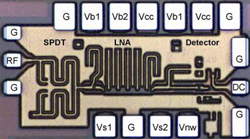
| Home | About Us | Contribute | Bookstore | Advertising | Subscribe for Free NOW! |
| News Archive | Features | Events | Recruitment | Directory |
| FREE subscription |
| Subscribe for free to receive each issue of Semiconductor Today magazine and weekly news brief. |
News
29 June 2009
UCSD presents first W-band SiGe imaging chip
In a presentation selected as one of the best three student papers at the 2009 IEEE Radio Frequency Integrated Circuits (RFIC) Symposium in Boston, MA earlier this month (7-9 June), researchers in University of California, San Diego's Jacobs School of Engineering reported what is claimed to be the first W-band silicon-germanium (SiGe) radio-frequency integrated circuits (RFICs) for passive millimeter-wave imaging. It is reckoned that this could lead to significantly cheaper imaging systems for identifying concealed weapons, for helping helicopters to land during dust storms, and for high-frequency data communications.
Passive millimeter-wave imaging systems operating in the W-band (140-220GHz) provide high spatial and temperature resolution while penetrating obscurants such as dust, fog, or clothing (since mm-wave radiation emitted from the human body and from objects under a person's clothing can pass through clothing largely or completely unaffected). In particular, imagers operating at such wavelengths can resolve images down to the millimeter scale, which is fine enough to identify small objects and separate items on a person's body. Using signal processing, scanners can assemble an image of a temperature map of a person's body that includes any objects beneath the clothing. “By the size of the signal we detect, we can tell the temperature of the signal we are looking at,” explains project supervisor and electrical engineering professor Gabriel Rebeiz.
Existing passive mm-wave imaging systems use high-gain amplifiers based on gallium arsenide or indium phosphide followed by either a diode detector or a heterodyne mixer. The development in 2007 of low-noise, high-responsivity zero-bias diodes allowed unprecedented temperature resolution with only a 20dB-gain GaAs or InP pre-amplifier for passive imaging arrays. However, these diodes are not compatible with standard GaAs or InP epitaxial layers needed for the low-noise amplifiers, necessitating a two-chip solution.
The new W-band millimeter-wave amplifier system works at the same frequency and follows the same underlying principles as the most advanced security imaging systems currently used in airports. However, the new RFIC is unique in using standard silicon technology. “Other systems are typically customized and very expensive,” says first author and electrical engineering PhD student Jason May.
In contrast, due to recent advances in SiGe technologies, a low-cost system with high temperature resolution can be achieved. The low-noise W-band square-law detector was implemented in a commercial SiGe 0.12 micron BiCMOS technology (IBM’s 8HP process, with a unity-gain current cutoff frequency ft of 200GHz). The detector occupies just 0.14mm2 (including pads). This was integrated with a five-stage SiGe low-noise amplifier (LNA) to form a compact W-band passive imaging system. The LNA achieves a peak gain of 23dB and >20dB gain from 86-103 GHz.
The combined LNA+detector measures just 0.26mm2. It achieves a peak responsivity of about 4000kV/W at 94GHz with a minimum noise-equivalent power (NEP) of 0.014pW/Hz1/2 (compared to <1pW/Hz1/2 targeted by previous GaAs- or InP-based systems), and consumes a current of 29mA from a 1.2V supply. The chip can achieve a temperature resolution of 0.3-0.4K (on a par with 0.2-0.5K for previous systems) with an integration time of 30ms and a bandwidth of about 20GHz.
“An imager with our chip could resolve images down to a millimeter scale, enabling us to identify very small objects that are on someone's body,” said Rebiez. “A ceramic knife concealed against a person's leg, for instance, might appear one or half of one degree cooler than the rest of their body,” says May. “We could then tell that something is there and we could exactly determine its shape,” he adds.
“The technologies that we use are very inexpensive and reliable, so we should be able to bring the costs of those sorts of systems down, perhaps even to handheld scanners some day,” says May. The researchers hence believes that such imagers, high-speed communications systems, and other applications that operate at millimeter-wave frequencies are poised to become increasingly prevalent and influential as the circuit technologies for integrating them with existing silicon technologies matures.
The researchers add that they are currently testing a chip that integrates the LNA+detector with a W-band SPDT switch and a 50Ω reference resistor (for calibration purposes). The SPDT switch has a measured 2.8dB insertion loss, 19dB isolation, and 84-102GHz matching bandwidth. Measured responsivities are about 2000kV/W at 94GHz.
 Future designs will focus on removing the input noise from the bias network and increasing the LNA gain (to 30-33dB), targeting a 10-fold improvement in performance.
Future designs will focus on removing the input noise from the bias network and increasing the LNA gain (to 30-33dB), targeting a 10-fold improvement in performance.
Picture: W-band SiGe RFICs for passive millimeter-wave imaging.
![]() Search: SiGe
Search: SiGe
Visit: www.jacobsschool.ucsd.edu